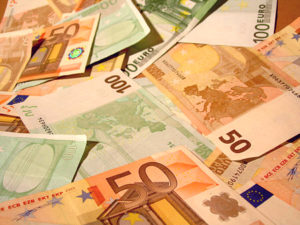 Yesterday’s trade saw EUR/USD within the range of 1.0928-1.1036. The pair closed at 1.0949, losing 0.57% on a daily basis. The daily low has also been the lowest level since July 7th, when the cross registered a low of 1.0915.
Yesterday’s trade saw EUR/USD within the range of 1.0928-1.1036. The pair closed at 1.0949, losing 0.57% on a daily basis. The daily low has also been the lowest level since July 7th, when the cross registered a low of 1.0915.
At 7:39 GMT today EUR/USD was down 0.41% for the day to trade at 1.0905. The pair broke the daily S1 level and touched a daily low at 1.0903 at 7:40 GMT. It has been the lowest level since June 1st, when a daily low of 1.0886 was registered.
Fundamentals
Euro area
Consumer Inflation – final estimate
The final annualized consumer inflation in the Euro zone, evaluated in accordance with Eurostat’s harmonized methodology, probably confirmed the preliminary rate at 0.2% in June, which was reported on June 30th. In May the final HICP reading pointed to annual inflation rate of 0.3%, which matched the preliminary estimate. According to the preliminary data, in June the rate was influenced by a sharper fall in energy prices (-5.1%, compared to -4.8% in May). Prices are expected to rise for food, alcohol and tobacco (up at an annualized rate of 1.2%), services (up 1.0% compared to 1.3% in May) and non-energy industrial goods (up 0.4% compared to a 0.2% gain in May).
The index shows the change in price levels of a basket of goods and services from consumer’s perspective and also reflects purchasing trends. The main components of the HICP are food, alcohol and tobacco (accounting for 19% of the total weight), energy (11%), non-energy industrial goods (29%) and services (41%).
The HICP is used to evaluate and compare inflation rates between Member States, according to Art. 121 of the Amsterdam’s Agreement and directives by the European Central Bank (ECB), in order the latter to achieve price stability and implement monetary policy. The HICP aggregates are calculated as a weighted average of each member state’s HICP components.
In case the HICP slowed down more than anticipated, thus, further distancing from the 2% inflation objective set by the ECB, this would mount selling pressure on the euro, because of the greater possibility of expanding the set of monetary policy measures in order to stimulate economic activity.
The final annualized Core HICP for June probably matched the preliminary core inflation estimate, which was reported at 0.8% on June 30th. In May the final annualized core inflation in the Euro area was registered at 0.9%, in line with the preliminary reading. This index excludes volatile categories such as food, energy, alcohol and tobacco. Eurostat is scheduled to release the final inflation data at 9:00 GMT.
ECB policy decision
At 11:45 GMT the European Central Bank (ECB) is to announce its decision in regard to borrowing costs. The median estimate by experts suggests that the central bank will probably maintain its benchmark interest rate at the record low level of 0.05% at the policy meeting today. The bank last reduced the refinancing rate by 10 basis points to the current 0.05% at the September 4th 2014 meeting. This has been the fourth time last year, when the ECB cut its benchmark.
At its meeting on June 3rd the central bank kept the marginal lending facility intact at 0.30% and the deposit facility at -0.20%. In March the bank initiated purchasing public and private sector assets worth 60 billion euros a month.
According to extracts from the Introductory statement to the press conference, offered by ECB President, Mario Draghi: “Regarding non-standard monetary policy measures, the asset purchase programmes are proceeding well. As explained on previous occasions, our asset purchases of €60 billion per month are intended to run until the end of September 2016 and, in any case, until we see a sustained adjustment in the path of inflation that is consistent with our aim of achieving inflation rates below, but close to, 2% over the medium term.”
“Our monetary policy measures have contributed to a broad-based easing in financial conditions, a recovery in inflation expectations and more favourable borrowing conditions for firms and households. The effects of these measures are working their way through to the economy and are contributing to economic growth, a reduction in economic slack, and money and credit expansion.”
“In the first quarter of 2015, real GDP in the euro area rose by 0.4%, quarter on quarter, after 0.3% in the last quarter of 2014. In recent quarters, domestic demand and, particularly, private consumption were the main drivers behind the ongoing recovery.”
“This assessment is also broadly reflected in the June 2015 Eurosystem staff macroeconomic projections for the euro area, which foresee annual real GDP increasing by 1.5% in 2015, 1.9% in 2016 and 2.0% in 2017. Compared with the March 2015 ECB staff macroeconomic projections, the projections for real GDP growth over the projection horizon remain virtually unchanged.”
ECB policy makers aim to keep prices in the region stable, while stability is defined as a year-on-year increase in the Harmonized Index of Consumer Prices (HICP) for the Euro zone of below, but close to 2%.
Short-term interest rates are of utmost importance for the valuation of national currencies. In case the European Central Bank is dovish about inflationary pressure and overall economic activity in the Euro area and, thus, either puts interest rates on hold, or reduces them further, this will usually cause a bearish impact on the common currency.
The interest rate decision is to be followed by the press conference with ECB President Mario Draghi, during which volatility of euro crosses is usually high. In case Draghi offers a more hawkish tone, the euro will usually receive support, while a more dovish tone will have a bearish effect on the currency. The press conference is scheduled at 12:30 GMT.
United States
Initial, Continuing Jobless Claims
The number of people in the United States, who filed for unemployment assistance for the first time during the week ended on July 10th, probably decreased to 285 000 from 297 000 in the prior week. The latter has been the highest number of claims since the week ended on February 27th, when 320 000 claims were reported. The 4-week moving average, an indicator lacking seasonal effects, was 279 500, marking an increase of 4 500 from the previous weeks revised up average.
Initial jobless claims number is a short-term indicator, reflecting lay-offs in the country. In case the number of claims dropped more than projected, this would have a bullish effect on the greenback.
The number of continuing jobless claims probably fell to the seasonally adjusted 2 295 000 during the week ended on July 3rd. There were 2 334 000 claims registered during the week ended on June 26th. The latter represented an increase by 69 000 compared to the revised up number of claims, reported during the week ended on June 19th. This indicator reflects the actual number of people unemployed and currently receiving unemployment benefits, who filed for unemployment assistance at least two weeks ago.
The Department of Labor is to release the weekly report at 12:30 GMT.
Philadelphia Fed Manufacturing Index
The Philadelphia Fed Manufacturing Index probably fell to a reading of 12.0 in July from 15.2 index points during the previous month. The latter has been the highest level since December 2014, when the gauge was reported at 24.5. The index is based on a monthly business survey (the Business Outlook Survey), measuring manufacturing activity in the third district of the Federal Reserve, Philadelphia. Participants give their opinion about the direction of business changes in overall economy and different indicators of activity in their companies, such as employment, working hours, new and existing orders, deliveries, inventories, delivery time, price etc. The survey is conducted every month since May 1968. The results are presented as the difference between the percentages of positive and negative projections. A level above zero is indicative of improving conditions, while a level below zero is indicative of worsening conditions. Lower-than-expected index readings would have a certain bearish effect on the greenback. The Federal Reserve Bank of Philadelphia is expected to release the official results from the survey at 14:00 GMT.
Yellens testimony
Also at 14:00 GMT Federal Reserve Chair Janet Yellen is to testify before Congress. Medium-to-high volatility across the board could be introduced during the Questions & Answers session following the testimony.
Bond Yield Spread
The yield on German 2-year government bonds went as high as -0.215% on July 15th, after which it slid to -0.235% at the close to lose 1.4 basis points (0.014 percentage point) on a daily basis.
The yield on US 2-year government bonds climbed as high as 0.677% on July 15th, after which it fell to 0.645% at the close to gain 0.004 percentage point for the day.
The spread between 2-year US and 2-year German bond yields, which reflects the flow of funds in a short term, expanded to 0.880% on July 15th from 0.868% during the prior day. The July 15th spread has been the most notable one since July 13th, when the difference was 0.910%.
Meanwhile, the yield on German 10-year government bonds soared as high as 0.847% on July 15th, after which it slid to 0.756% at the close to lose 8.7 basis points (0.087 percentage point) compared to July 14th, while marking a third straight day of decrease.
The yield on US 10-year government bonds climbed as high as 2.432% on July 15th, after which it slipped to 2.372% at the close to lose 2.5 basis points (0.025 percentage point) on a daily basis, while marking a second consecutive day of decrease.
The spread between 10-year US and 10-year German bond yields expanded to 1.616% on July 15th from 1.548% during the prior day. The July 15th yield difference has been the largest one since July 7th, when the spread was 1.618%.
Pivot Points
According to Binary Tribune’s daily analysis, the central pivot point for the pair is at 1.0971. In case EUR/USD manages to breach the first resistance level at 1.1014, it will probably continue up to test 1.1079. In case the second key resistance is broken, the pair will probably attempt to advance to 1.1122.
If EUR/USD manages to breach the first key support at 1.0906, it will probably continue to slide and test 1.0863. With this second key support broken, the movement to the downside will probably continue to 1.0798.
The mid-Pivot levels for today are as follows: M1 – 1.0831, M2 – 1.0885, M3 – 1.0939, M4 – 1.0993, M5 – 1.1047, M6 – 1.1101.
In weekly terms, the central pivot point is at 1.1096. The three key resistance levels are as follows: R1 – 1.1276, R2 – 1.1393, R3 – 1.1573. The three key support levels are: S1 – 1.0979, S2 – 1.0799, S3 – 1.0682.





